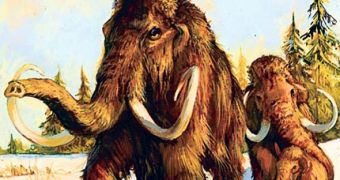Currently, we can see mammoths only in animation, but modern science could bring back them 'live and kicking'. DNA, the heredity molecule, has everything to do with this issue. Complete DNA sequences have been decoded for many living species, like humans, dogs and mice. And the DNA of long-extinct species can also be found preserved in bones or bodies encountered in dry caves or inside ice, for example.
"Retrieval of DNA from ancient specimens is relatively easy now," said Alan Cooper, of the University of Adelaide in Australia. The ancient DNA has broken down into thousands of small pieces, but it can be still read and pieces can still be put together. That's why assembling the DNA of Neanderthals or of mammoths is just around the corner.
A team led by Stephan Schuster and Webb Miller at Pennsylvania State University and Tom Gilbert at the University of Copenhagen is using the DNA of woolly mammoths preserved in the Siberian permafrost.
"I think it's definitely feasible to assemble these genomes, but it's going to be extremely hard work," said Eske Willerslev of the University of Copenhagen in Denmark.
A team led by Svante Paabo at the Max Planck Institute in Leipzig, Germany, is doing the same with Neanderthal genome from bones preserved in arid caves.
"Only certain types of errors appear in such ancient DNA, paving the way for scientists to more easily anticipate and correct gaps in their knowledge." said Paabo.
But resurrecting these creatures "is for the most part science fiction," Paabo argued.
"As far as I can see, it is not going to be practical. That's because researchers are reading little fragments of preserved DNA and guessing at what the original genetic instructions were. You're not actually physically putting the DNA together, and I can't see any way of doing that feasibly," Cooper said.
"In large part, the problem is that living animals package their DNA with proteins that help it wind up into chromosomes. This packaging is crucial to making the DNA work properly," he argues.
"The only way he could see of bringing back an extinct species like a mammoth would be to find an extremely well-preserved cell." said Willersley.
"That's extremely unlikely to happen, because all parts of a cell break down over time, even in mammoths that have been encased in ice since they died. But researchers working on cloning have contacted me, wanting to get a hold of mammoth tissue so they could try to clone a mammoth. I was surprised. I thought it was completely ridiculous. I don't think they will find anything they can use in the frozen tissue".
Japanese scientists have been looking for years for a preserved mammoth with intact sperm, for re-creating the beast, an approach regarded as unlikely by many. Miller is not so skeptical.
"Do they also say that synthesizing a virus will never be possible?" he said, pointing to the 2005 accomplishment when researchers managed for the first time to revive the deadly 1918 flu from preserved tissue samples.
"What about a bacterium? A yeast? A fruit fly? I'm curious where the line can be drawn." said Miller.
"It's theoretically possible, and I think it's going to be done at some point. Once you have the genome of a mammoth, you could compare it with the genome of its closest relative, the Asian elephant." said Hendrick Poinar, of McMaster University in Canada.
"Then you could genetically engineer the elephant DNA, point by point, so that it matches the mammoth DNA. Then, by inserting this modified DNA into an elephant's egg cell, and implanting it in an elephant's womb, you could create a modified elephant that's nearly identical to the original mammoth," he said.
"I wouldn't be surprised if, in ten years, you'd be able to synthesize chromosome-length DNA. Five years ago everybody was saying you'd never be able to sequence the genomes of extinct animals ... but here we are. The more poignant question is whether this should be done. It's not clear where we'd put a herd of mammoths, for example, and the natural predators that once hunted them-other than people-are also extinct. I can't think of a good reason to do it, other than the 'wow' value." he added.

 14 DAY TRIAL //
14 DAY TRIAL //